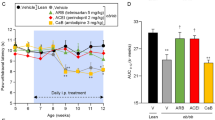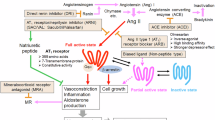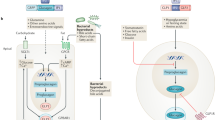Abstract
Large-scale trials with angiotensin converting enzyme (ACE) inhibitors and angiotensin II type 1 (AT1)-receptor blockers have clearly shown that blockade of the renin-angiotensin system reduces the deterioration in renal function associated with diabetes. AT1-receptor blockers represent a more rational approach to blockade of this system than ACE inhibitors, due to the presence of non-ACE pathways of angiotensin II formation. Studies in healthy volunteers maintained on a low-salt diet indicate that such pathways account for approximately 30–40% of total angiotensin II formation, and this figure increases to 60–70% in individuals maintained on a high-salt diet (resembling the situation in most human populations). Activation of the renin-angiotensin system is increased in diabetic patients, and comparison of the renal vascular responses to captopril and candesartan shows a strong correlation between the effects of ACE inhibition and AT1-receptor blockade, indicating that the deleterious effects of renin-angiotensin system activation in diabetes are mediated largely through angiotensin II. The presence of multiple risk factors, such as genetic predisposition, hyperglycaemia, obesity and tissue damage, places diabetic patients at high risk of disease related to activation of the renin-angiotensin system. Effective and early blockade of this system is therefore an important aspect of management.
This is a preview of subscription content, access via your institution
Access options
Subscribe to this journal
Receive 12 digital issues and online access to articles
$119.00 per year
only $9.92 per issue
Buy this article
- Purchase on SpringerLink
- Instant access to full article PDF
Prices may be subject to local taxes which are calculated during checkout





Similar content being viewed by others
References
Lewis EJ, Hunsicker LG, Bain RP, Rohde RD . The effect of angiotensin-converting enzyme inhibition on diabetic nephropathy N Engl J Med 1993 329: 1456–1462
Lewis EJ et al. Renoprotective effect of the angiotensin receptor antagonist irbesartan inpatients with nephropathy due to type 2 diabetes N Engl J Med 2001 345: 851–860
Brenner BM et al. Effects of losartan on renal and cardiovascular outcomes inpatients with type 2 diabetes and nephropathy N Engl J Med 2001 345: 861–869
Parving H-H et al. The effect of irbesartan on the development of diabetic nephropathy inpatients with type 2 diabetes N Engl J Med 2001 345: 870–878
Fisher ND, Hollenberg NK . Is there a future for renin inhibitors? Expert Opin Investig Drugs 2001 10: 417–426
Urata H et al. Angiotensin II-forming pathways in normal and failing human hearts Circ Res 1990 66: 883–890
Okunishi H et al. Marked species-difference in the vascular angiotensin II-forming pathways: humans versus rodents Jap J Pharmacol 1993 62: 207–210
Powell JS et al. The proliferative response to vascular injury is suppressed by angiotensin-converting enzyme inhibition J Cardiovasc Pharmacol 1990 16 (Suppl 4): S42–S49
Powell JS et al. Inhibitors of angiotensin-converting enzyme prevent myointimal proliferation after vascular injury Science 1989 245: 186–188
The MERCATOR Study Group. Does the new angiotensin converting enzyme inhibitor cilazapril prevent restenosis after percutaneous transluminal coronary angioplasty? Results of the MERCATOR study: a multicenter, randomized, double-blind placebo-controlled trial Circulation 1992 86: 100–110
Hollenberg NK . The renin-angiotensin-aldosterone system, blockade and diabetic nephropathy JRAAS 2001 2 (Suppl 1): S185–S187
Cordero P et al. Renal and endocrine responses to a renin inhibitor, enalkiren, in normal humans Hypertension 1991 17: 510–516
Hollenberg NK, Fisher NK . Renal circulation and blockade of the renin-angiotensin system Is angiotensin-converting enzyme inhibition the last word? Hypertension 1995 26: 602–609
Price DA, De'Oliveira JM, Fisher NDL, Hollenberg NK . Renal hemodynamic response to an angiotensin II antagonist, eprosartan, in healthy men Hypertension 1997 39: 240–246
Price DA et al. The paradox of the low-renin state in diabetic nephropathy J Am Soc Nephrol 1999 10: 2382–2391
Hollenberg NK et al. Salt intake and non-ACE pathways for intrarenal angiotensin II generation in man JRAAS 2001 2: 14–18
The Diabetes Control and Complications Trial Research Group. The effect of intensive treatment of diabetes on the development and progression of long-term complications in insulin-dependent diabetes mellitus N Engl J Med 1993 329: 977–986
Marre M et al. Contribution of genetic polymorphism in the renin-angiotensin system to the development of renal complications in insulin-dependent diabetes: Genetique de la Nephropathie Diabetique (GENEDIAB) study group J Clin Invest 1997 99: 1585–1595
Hadjadj S et al. Prognostic value of angiotensin-I converting enzyme I/D polymorphism for nephropathy in type 1 diabetes mellitus: a prospective study J Am Soc Nephrol 2001 12: 541–549
Lansang MC et al. Renal vascular responses to captopril and to candesartan inpatients with type 1 diabetes mellitus Kidney Int 2001 59: 1432–1438
Ikoma M et al. Cause of variable therapeutic efficacy of angiotensin converting enzyme inhibitor on glomerular lesions Kidney Int 1991 40: 195–202
Palla R et al. Effect of increasing doses of lisinopril on proteinuria of normotensivepatients with IgA nephropathy and normal renal function Int J Clin Pharmacol Res 1994 14: 35–43
Gansevoort RT et al. Effects of the angiotensin II antagonist losartan in hypertensivepatients with renal disease J Hypertens 1994 12 (Suppl): S37–S42
Weinberg MS, Weinberg AJ, Cord R, Zappe DH . The effect of high-dose angiotensin II receptor blockade beyond maximal recommended doses in reducing urinary protein excretion JRAAS 2001 2 (Suppl 1): S196–S198
Osei SY et al. Hyperglycemia and angiotensin-mediated control of the renal circulation in healthy humans Hypertension 1999 3: 559–564
Author information
Authors and Affiliations
Rights and permissions
About this article
Cite this article
Hollenberg, N. AT1-receptor blockade and the kidney: importance of non-ACE pathways in health and disease. J Hum Hypertens 16 (Suppl 3), S59–S63 (2002). https://doi.org/10.1038/sj.jhh.1001441
Published:
Issue date:
DOI: https://doi.org/10.1038/sj.jhh.1001441
Keywords
This article is cited by
-
How high should an ACE inhibitor or angiotensin receptor blocker be dosed in patients with diabetic nephropathy?
Current Hypertension Reports (2003)



